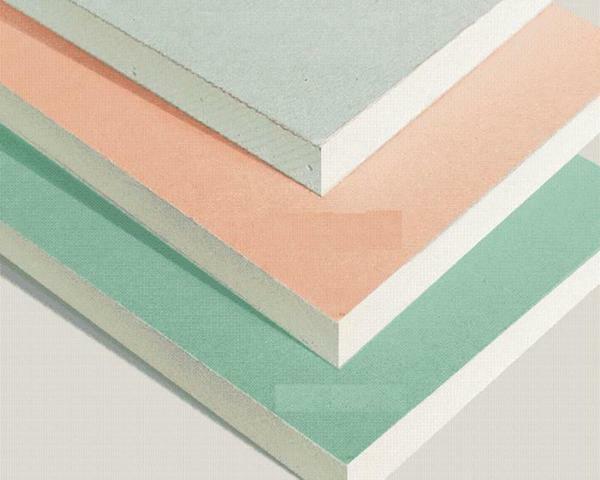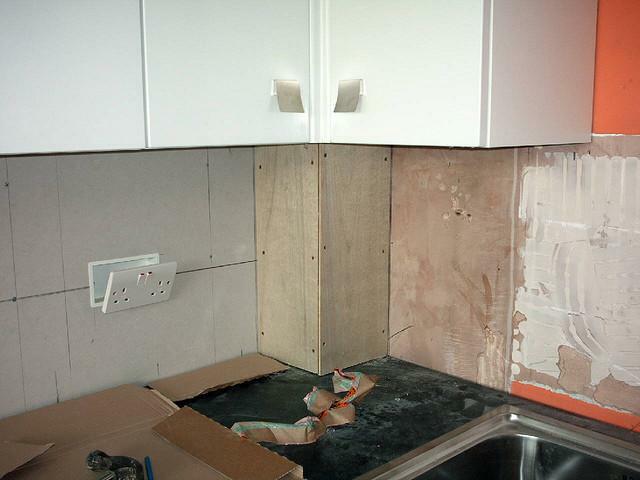 With the help of drywall you can stylishly and beautifully decorate the bathroom Any person wants to give his home a beautiful and well-groomed appearance, and such details as peeping out from under the tub water pipes or standing in the corner of the bucket can completely bring to naught, All his efforts. Drywall in the bathroom will help eliminate this problem by visually hiding all the small details and inaccuracies.
With the help of drywall you can stylishly and beautifully decorate the bathroom Any person wants to give his home a beautiful and well-groomed appearance, and such details as peeping out from under the tub water pipes or standing in the corner of the bucket can completely bring to naught, All his efforts. Drywall in the bathroom will help eliminate this problem by visually hiding all the small details and inaccuracies.
-
- Plasterboard for the bathroom - a material for the realization of fantasies in reality
- GKL tubing in the bathroom
- Types of screens for the plasterboard bath: solid and sliding
- How to make a screen for a bath of plasterboardWith their own hands
- Application of plasterboard in the bathroom( video)
Drywall for the bathroom - material for the realization of fantasy in reality
Drywall is convenient and practical in useThe material. With its help you can make the walls and ceiling perfectly smooth, hide the elements of communications, create a niche for storing things, build an angular or curvilinear design. In the bathroom, the plasterboard partitions look always organic and do not take away a useful place.
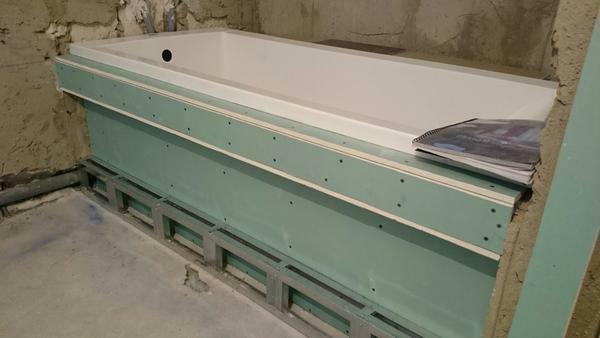 For bathroom arrangement it is better to choose special moisture-resistant sheets of drywall
For bathroom arrangement it is better to choose special moisture-resistant sheets of drywall
Advantages of plasterboard partitions:
- Special moisture-resistant sheets of gypsum board are used for finishing. They are able to withstand the long-term exposure to moisture and steam, as the material is impregnated with antifungal additives that do not allow mold and fungus to form on its surface.
- Partitions made of gypsum cardboard make it possible to differentiate the useful area, make it more functional and practical, so they are often used in spacious bathrooms. Free space is arranged so that all necessary household items are located at hand.
- If a mixer is to be placed on the plasterboard, then this zone should be strengthened with finishing materials or additional sheets of plasterboard. Strengthening gipsokartonnoy walls and will be required in places most prone to various shocks. For example, if a shower, a washing machine or a water heater are installed near the wall.
- Special attention should be paid to waterproofing works. They are produced after the gypsum board has been installed. For this, a sealing tape must be laid on all joints, which is then treated with a water-repellent sealant. This waterproofing will help to avoid moisture from falling under the drywall, which is fraught with the appearance of mold.
These advantages speak for themselves, so in modern construction and decoration, drywall is so in demand.
GKL pipes in the bathroom
Drywall allows you to hide all impartial elements of communication: water and sewage pipes. This difficulty is solved by the construction of a box, which can be demountable, or equipped with doors to access the pipes.
To avoid condensation, pipes must be treated with special care.
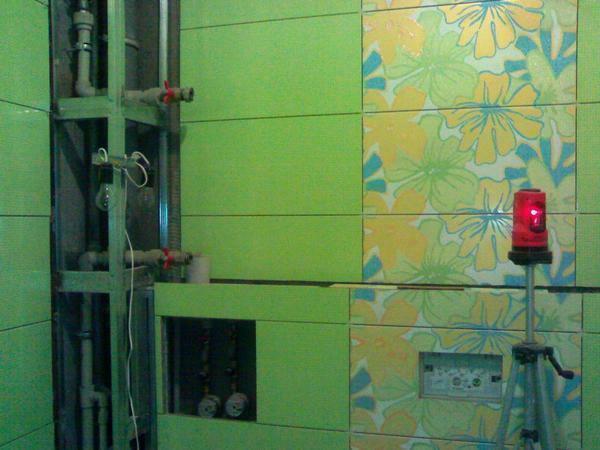 Drywall is a plastic material that is why it will easily help you to hide the GKL pipes in the bathroom in a stylish and beautiful way
Drywall is a plastic material that is why it will easily help you to hide the GKL pipes in the bathroom in a stylish and beautiful way
First of all, they are covered with a primer, in the next step, with several layers of paint, and then carefullyWrapped in mineral wool. All this procedure will avoid corrosion on the pipes.
The installation of the box is made using the following technology:
- Pipe marking. During the measurements it should be remembered that the intermediate distance between the duct and the pipe should be about 4 cm. The places in which the meters are placed on the water and the valves must be equipped with doors.
- Fastening of a skeleton from a metal profile.
- Finishing of GKL.The sheets of gypsum cardboard are attached to the frame using self-tapping screws.
If desired, the gypsum board can be trimmed with finishing material. The most suitable material is tile, used for finishing the walls and floor of the bathroom. So, you can achieve that the box will not visually stand out from the stylistic design of the room.
Types of screens for a bath of plasterboard: solid and sliding
The screen allows you to close the plumbing, make it visually inaccessible to the outside view, giving the room an aesthetic and harmonious appearance.
Types of screens in the bathroom:
- Solid;
- Sliding.
 Many designers recommend using drywall as a special screen for a bath
Many designers recommend using drywall as a special screen for a bath
Let's look at each one in detail, and after that you can decide what is best for your bathroom.
Solid screens are considered to be the simplest. Typically, the screen uses the same material as for finishing the walls and floor of the room. Thus, the bathroom fits perfectly into the interior of the whole room.
Of the drawbacks can be noted - the lack of access to communication pipes. In case of possible leakage, the owners will have to completely open the screen, breaking and crushing it on their way.
The sliding screen looks less aesthetic. However, its functionality and convenience can not be denied. The owners have the opportunity to get to the drainpipes and drain pipes. In addition, they can store working tools or household chemicals under the bathroom, which is quite convenient.
How to make a screen for a bath of gypsum board with your own hands
You can make a screen from plasterboard yourself. For convenience, an algorithm of actions is given, which will not allow to get confused in the process. Adhere to the rules, and after a while the homemade screen will be ready.
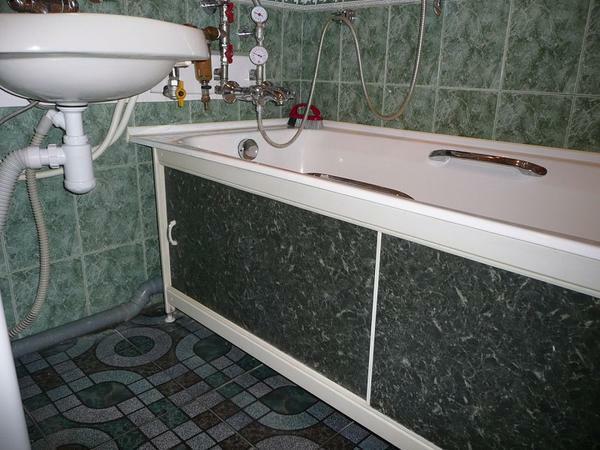 It is not difficult to make the screen for a bath, the main thing is to determine in advance its design and design
It is not difficult to make the screen for a bath, the main thing is to determine in advance its design and design
The algorithm is as follows:
- The metal frame is the base of the screen. First you need to build a frame for GKL mounting. Bathroom - a damp room, so the use of wooden slats - an impractical solution. To create a frame, you need to arm with metal profiles that are attached to the walls and floor using dowels.
- GKL skeleton casing. Fixation of gypsum boards is made by screws. They need to be fixed at a distance of 25cm each other. If you plan to finish the plasterboard with tiles, the screws of the screws need a little "drown" - this will help avoid inconvenience while laying the finishing material.
After this you can finish the finishing.
Ideally flat sheets of plasterboard allow you to proceed immediately after their installation to finishing works.
GCR sheets should be treated with a water-repellent compound, which will help to avoid the possible occurrence of mold and fungus. If the paint is used as a finishing, it is better to purchase waterproof varieties made on the basis of acrylic or latex.
Finishing of gypsum boards with tiles should be done only after scrupulous surface treatment with antiseptics and water repellent solutions. The greatest emphasis should be made during the grouting of the intertitic joints, since it is in these places that there is a large accumulation of bacteria and fungi.
Application of plasterboard in the bathroom( video)
Bathroom repair is a laborious process, capable of emotionally affecting all members of a large family. But the repair work, during which the gypsum boards are used, pass quickly and "painlessly".We hope that our instructions for working with plasterboard were useful to you.

